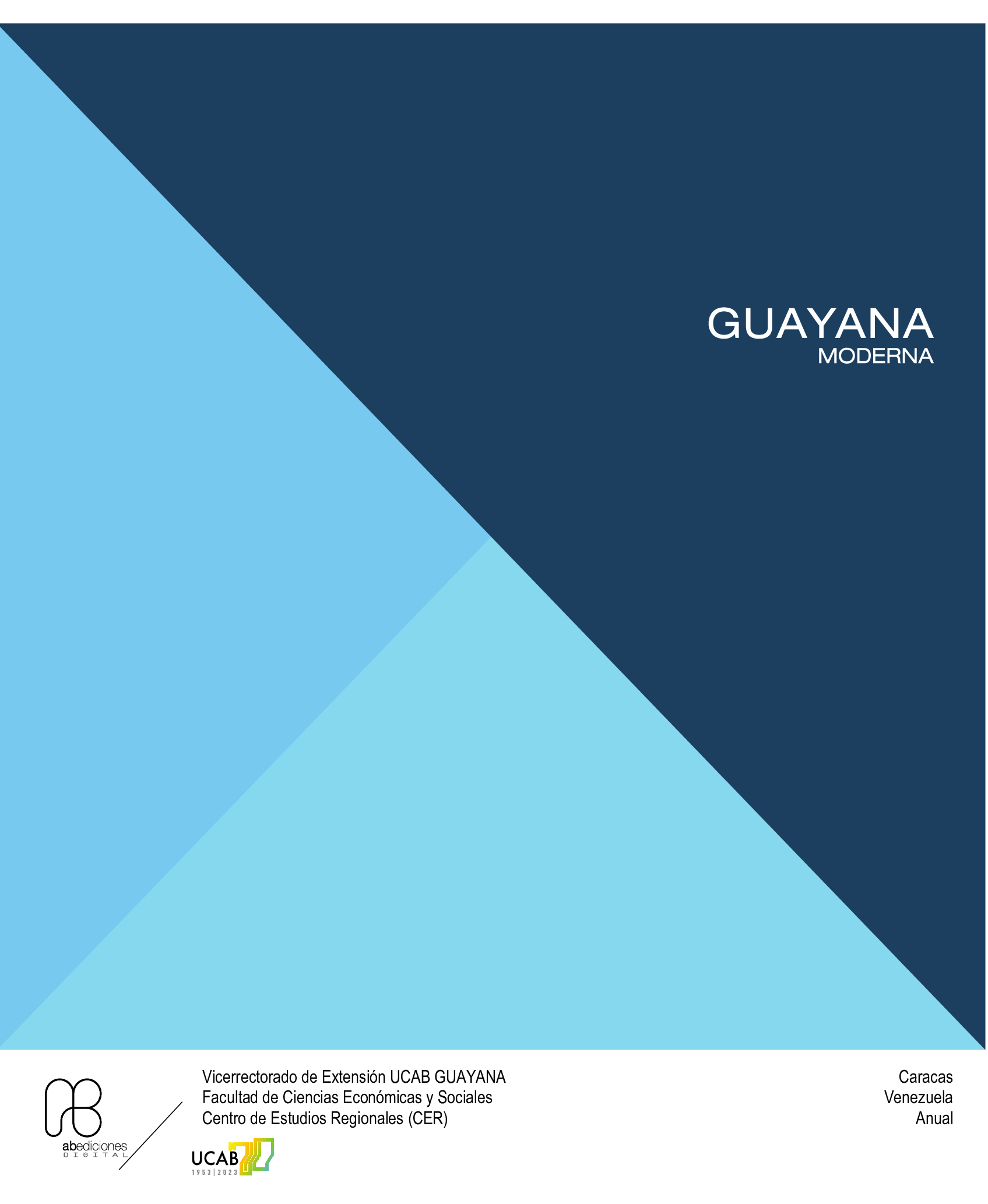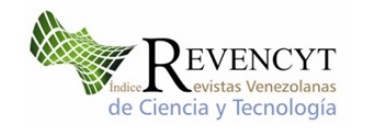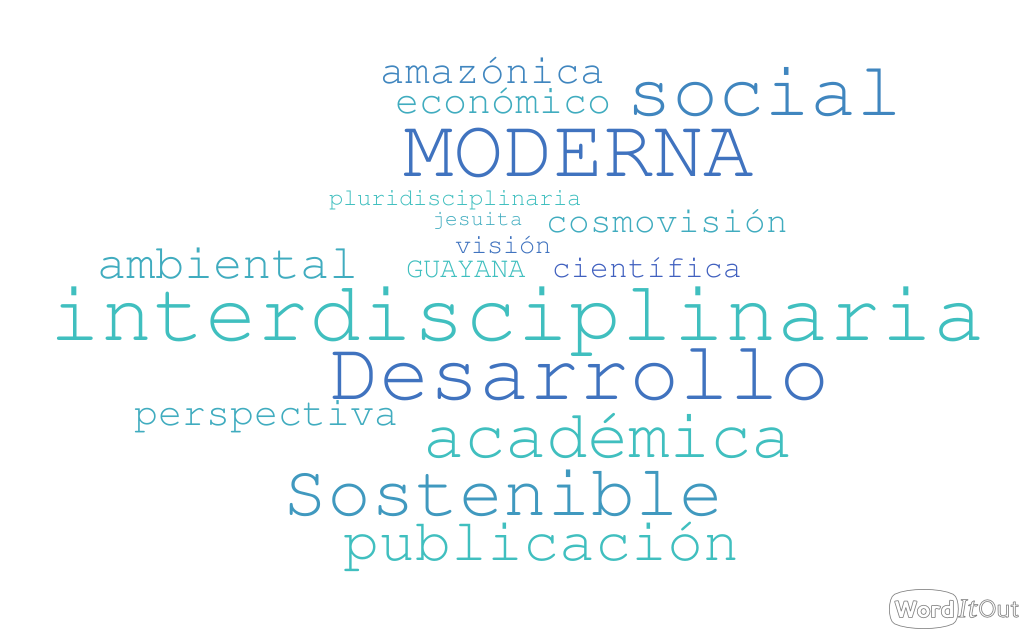Instructions for authors
Instructions to authors
Guayana Moderna Journal has the following sections: Articles, Essays, Research Note and Reviews.
The reception of papers for any of the four sections will be communicated in advance through a call for entries in the Notices section and in the different social networks of UCAB.
The call for papers will be open during the months of February and August of each year. As soon as a paper is received, it will be reviewed by the editorial team and then by anonymous peers within the following 15 days.
All originals received, which have passed the review of the editorial team, will follow the peer review process. Except for the reviews, as they will be reviewed and approved by the editorial team.
Guayana Moderna Journal does not charge for the submission of articles, nor does it charge for the publication of articles.
Guidelines for submission of articles:
The length of the contributions will be a minimum of 12 pages and a maximum of 20 (including annexes, appendices, images and references) on letter size paper with margins of 2.5 centimeters, written in Word with Times New Roman 12 point font, 1.5 line spacing and alignment of subtitles to the left.
On the first page, without abbreviations, the following data should be noted: a) Title of the article (centered), b) Name of the author(s) (on the right), c) Institution where he/she works and address, d) City and country, d) E-mail, e) ORCID.
Additionally, the following instructions must be followed:
Title: It will consist of a maximum of 15 words, it will be written in Spanish and English.
Summary: It will consist of a maximum of 250 words to express the type of work carried out, objectives, methodology, results, discussion and conclusions. Written in Spanish and English.
Introduction: All articles must include an introduction with a background of the work, its development and conclusions.
Keywords: between three and five. Written below the respective summary, in Spanish and English.
Tables: Tables must have a number, title, source and be referred to in the text. Graphs, schemes, diagrams, photographs or maps must be numbered, with title, source and be referred to in the text. The text of graphs, schemes, diagrams or maps must be legible
Images: in addition to being included in the text, with their title and respective numbering, they will be sent separately in jpg files and with a resolution of 300 dpi.
Bibliographic sources will not be footnoted.
APA style (seventh edition in English, fourth in Spanish) will be used in citations and references. The sources consulted should only consist of the cited sources and each reference should contain complete data according to the suggested standard.
Ways to quote:
If the textual quotation is less than 40 words long, the quoted text is enclosed in quotation marks. The author, the year and the page number (p.) or pages (pp.), or paragraph number (para.) from which the quoted fragment was taken literally are cited.
When the textual quote is more than 40 words, then a line of space is included before and after the quote, making it an independent block, double-spaced and without quotes. Additionally, the left margin is increased.
For citations in the body of the text:
The summary citation is entered in parentheses with the author's last name(s), followed by the year of publication. Example:
Based on the entire process of analysis and interpretation of the information collected through different sources, some principles were formulated to guide teacher training towards the development of critical thinking.
These principles were organized in terms of what to teach and how to teach (Balbi, 2017).When the quote is also literal or verbatim, the page number or specific location of the phrase/s in the original text is included. Example:
From these and other considerations it is possible to say that a competence in education is: "a set of social, affective behaviors and cognitive, psychological, sensory and motor skills that allow the proper performance of a role, a performance, an activity or a task." ». (Argudín, 2005, p. 15).
The in-text citation for papers with three or more authors is shortened from the first citation. It only includes the name of the first author and "et al. Regarding in-text citation of a work with two authors: always cite both authors joined by "and". Example:
(Garcia and Restrepo, 2019)
(Jeans et al., 2016).
Bibliographical references:
The section will be titled “Bibliographical references”, it will appear at the end of the article and will contain only the sources that support the research and that have been used for the preparation of the work. Therefore, each entry in the reference list must be cited in the text.
References should appear in alphabetical order of the author's last name (or first author) and in lowercase letters.
The works by the same author are ordered chronologically from the oldest to the current. References by the author alone will appear first and works with other authors will appear second. When several works by the same author appear, the name is repeated for each entry. If an author has several works in a year, they will be differentiated alphabetically: Leff, 2019a; Leff, 2019b…
Bibliographic references that have DOI (Digital Object Identifier) will incorporate it at the end with link format, complete and secure URL, without prefixes.
For example: https://doi.org/10.xxxxx/xxxxx
You can check the DOI of a list of references on Crossref's Simple Text Query page.
Printed book
Last name(s), Initial of first name(s). (Year of publication). Book title (in italics). Editorial.
Example: Argudín, Y. (2006). Educación basada en competencias. Trillas.
Electronic book version with or without DOI
Last name(s), Initial of first name(s). (Year). Book title (in italics). (After the title, the DOI of the document is included, if it has one, or the full URL if it does not have it) https://doi.org/10.xxxx/xxxxxx or http://www.xxxxxx.xxx
Book with compiler, editor, director or coordinator(s) in print
Last name(s), Initial of first name(s). (abbreviated position, that is, Ed(s), Coord(s) or...). (Year). Book title (in italics). Editorial.
Book electronic version with compiler, editor, director or coordinator(s) with or without DOI
Last name(s), Initial of first name(s). (abbreviated position). (Year). Book title (in italics). (After the title, the DOI of the document is included, if it has one, or the full URL if it does not have it) https://doi.org/10.xxxx/xxxxxx or http://www.xxxxxx.xxx
Chapter of printed book
Last name(s), First name initial(s). (Year). Title of chapter, entry or contribution. In First name initial(s). Last name(s) of the editor(s) or coordinator(s) or.... (abbreviated title). Title of the book (pp. xx-xx). Publisher.
Chapter of digital book with DOI
Last name(s), First name initial(s) (Year). Title of chapter, entry or contribution. In First name initial(s). Surname(s) of the editor(s) or coordinator(s) or.... (abbreviated title). Title of the book (pp. xx-xx). https://doi.org/10.xxxx/xxxxxx
Printed magazine article
Last name(s), First name initial(s). (Year). Title of the article. Title of the publication, volume (number), (pages) xx-xx.
Digital journal article with or without DOI
Last name(s), First name initial(s), (Year). Title of the article. Title of the publication, volume (number), xx-xx. (After the pages include the DOI of the document, if it has one, or the complete URL if it does not) https://doi.org/10.xxxx/xxxxxx or http://www.xxxxxx.xxx.
Doctoral thesis. Final Degree Works. Master's Thesis
Last name, First name initial(s) (Year). Title of the thesis (Doctoral thesis /Final thesis / Unpublished Master's thesis). University of. Location. http://www.xxxxxx.xxx
Interviews
If the interview is retrievable, then you will need to choose in which format. It may be an interview available in a YouTube video file, on a web page, or in a podcast, for example. If it is not retrievable, you should cite it as a personal communication. See full APA Style 7th ed. on how to cite interviews.
Websites
Last name, First initial(s). o Name of the Institution (Year). Title of the web site. The digital object identifier ( DOI) of the document if it has one or the complete URL if it does not have a DOI.
Works with no edition date
To be indicated as follows (n.d.)
Peraza, C. (n.d.). xxxxxxxxxx
Types of contributions:
Scientific and technical research papers:
It presents, in detail, the original results of completed research projects, with sole authorship or in collaboration with researchers from other regional, national or international institutions, which constitute a contribution to their area of knowledge. They contain, at least, the following parts: summary, introduction, methodology, results, discussion, conclusions and references. Its length varies between 12 and 20 pages. Up to four authors are accepted. Technical Articles with a different structure could be accepted, according to the area of knowledge in question.
Academic paper:
It is a document that presents a theoretical contribution by an author or authors (maximum three) in a specific area of knowledge, based on concepts, experiences and research. Different categories are used to approach the topic to be dealt with, supporting it through authors that sustain, debate and allow the dialogue of knowledge. It consists of the following parts: summary, introduction, methodology, results, discussion, conclusions and references. Length between 12 and 20 pages.
Article from experiences of social or didactic action:
This type of material refers to the scope of the experience and gives an account of it. It must express its own purposes and show independence with respect to the project or experience that sustains it, demonstrating semantic self-sufficiency. It consists of the following parts: Introduction, state of the art or background, conceptual references, methodological strategies used, results, analysis and discussion. References, tables or graphs (if applicable). Appendices or complementary materials (if applicable). Length between 12 and 20 pages. A maximum of two authors is allowed..
Research report:
It is a text that reports on the current state or results of a study or research on a specific topic. The essential thing is to realize something that happened, with an explanation that allows you to understand it. The report is a written document that contains: problem, justification, objectives, theoretical framework, methodology, results, conclusions and references. Length between 12 and 20 pages. A maximum of three authors is acceptable.
Essays:
It must constitute a contribution to the area of knowledge in which it is limited and present results from an analytical, interpretive, or critical perspective of the author, supported by solid arguments on a specific topic and resorting to original sources. It consists of Introduction, Development,
Conclusions and References. Length between 6 and 12 pages. A maximum of three authors is acceptable.
Reflection article:
Document in which the results of completed research are presented from an analytical, interpretive or critical perspective of the author, on a specific topic, resorting to original sources. It must constitute a contribution to the area of knowledge in which it is limited. Length between 6 and 12 pages.
Article review:
A review article is a retrospective analysis of studies compiled in the literature on a topic considered interesting to a general or specialized audience. Its readers expect to find scientific veracity, breadth of sources reviewed, experience of the authors on the topic addressed, and recommendations appropriate to the environment in which they will be applied. It is characterized by presenting a careful literature review of at least thirty (30) references. Length between 12 and 25 pages.
Reviews:
Summaries of no more than three (3) pages about a book, doctoral thesis, master's degree work, article or other research work published recently (maximum 3 years), whose reading and discussion is part of the current debate in some area of CER interest. They can also be summaries of works published in other languages. The intention is to promote and recommend the latest specialized readings, as well as the discussion of the ideas contemplated therein..
Research Notes:
The research note is a type of research article, often between 3 and 5 pages in length (between 3,000 and 4,000 words). The text may be accompanied by graphs, tables, photographs and drawings, among others. The structure of a research note is generally the same as that of a scientific paper, only shorter. It follows the IMRYD system: Introduction, Methodology, Results and Discussion. The discussion may include conclusions. A maximum of two authors is accepted.
Submission guidelines
Reviews should be submitted in the same manner as research papers.
The reviews published in Guayana Moderna Journal will deal with scientific books published in the last three years related to the topics of the journal.
The maximum length of the texts should not exceed 2,000 words.
The text will be headed by bibliographic data and must also follow the APA citation model used by the journal for the publication of its articles.
During the submission process, in the “Summary” section of the journal platform, this information must be entered as follows: Author's surname, First name. Post title. Name of the editor, translator or coordinator. City: Publisher, year, ISBN, number of pages. It is recommended to include a term in the "Keywords" section during the submission process.
It is advisable to send, as a complementary file, an image of the book cover, which will be used in the preparation of the review.







